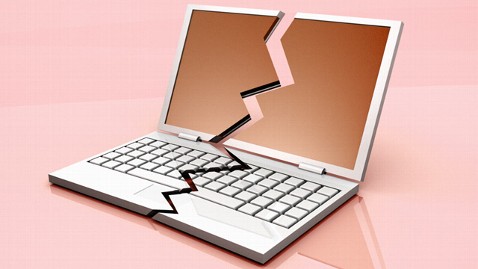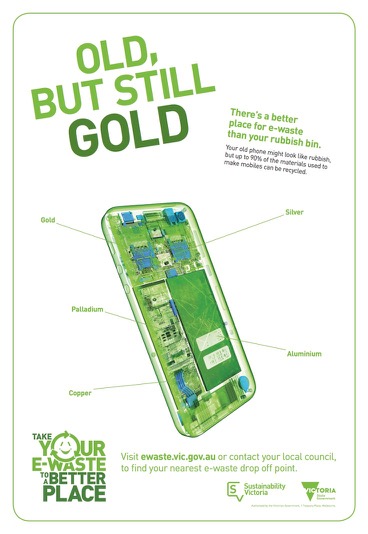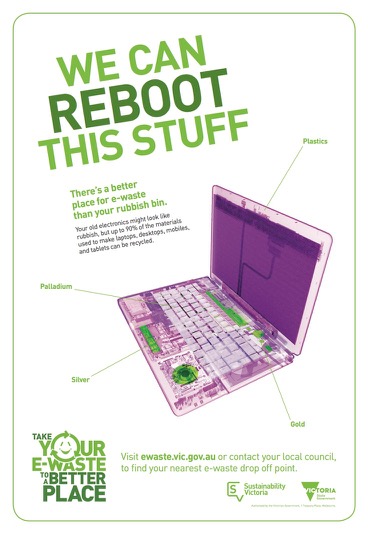As painfully ironic as it is, I’m writing this article about electronics waste from my friend’s laptop as yesterday I poured water on my laptop and broke it.
I would like to say this is the first one I’ve broken, but under my bed is a graveyard of broken electronics that I’ve damaged. Some from liquid, others from dropping and some just froze, and I gave up on them.
Sadly, I’m not the only clumsy person around, and shockingly e-waste in Australia is one of the fastest growing types of waste.
Image via Manrepeller

According to a 2013 study by the Australian Bureau of Statistics, Australian’s are among the highest users of technology with 99% of Australian households having at least one TV. The modern world is technology driven, and yet the statistics on electronics waste is disgusting, it predominately goes straight to landfill and seeps over time into the soil.
‘Of the 15.7 million computers that reached their ‘end of life’ in Australia in 2007-08, only 1.5 million were recycled – that’s less the 10%’ – Total Environment Centre 2008, Tipping Point: Australia’s E-Waste Crisis
Thinking about my own lifestyle, I live in a shared house of five people, and we have two TVs, a fridge, a washing machine, lamps, power drills, a microwave 6+ laptops, kitchen products, hair dryers, heaters, and multiple work and personal phones.
I personally have had over five laptops in my current lifetime, countless phones and other gadgets such as hair dryers…and I don’t even think I’m that technology driven!
How many electronics have you’ve previously owned and where are they now?

Waste is treasure
In an increasingly technology-driven world, e-waste (electrical and electronic equipment waste) is a huge issue. It’s not only an environmental issue; electronics waste can also affect health through toxic substances seeping into the surrounding land.
‘Disposal of unwanted televisions, computer products and other electrical or electronic devices in an environmentally responsible way is becoming an increasingly important issue due to the increase in consumption of raw materials, taking up of landfill space and disposal of hazardous substances in areas where they could leach into soil and water.’ – Australian Bureau of Statistics, 2013
It’s widely reported globally that electronics end up dumped in landfill, still containing valuable materials that could have been re-used or recycled. For example computers, laptops and phones contain non-renewable metals such as silver and gold. The Australian government has so far missed out on this gold mine, with a reported total economic loss of metal value from e-waste to be up to US$ 170 million a year.
Business Sense
Electronics companies are starting to clock on to the value of closed-loop initiatives, bringing in further revenue from re-using or recycling old products. One example is Apple; they offer trade-ins for store credit with Apple GiveBack. They then make money back through selling on the refurbished products. They also provide free recycling if the product isn’t eligible, ‘No matter the mode or condition, we can turn it into something good for you and good for the planet.’ Many other electronics companies are offering similar schemes, such as Dell’s Trade-In & Recycling Scheme.
I’d like to have more access to information from these companies, to ensure the schemes are ethical and not exploiting workers overseas.
There are other innovative companies popping up, solely focusing on tackling e-waste for both an environmental and/or economical benefit. Reverse Garbage is a creative reuse center that focuses on waste education in a fun way, through workshops and classes using donated waste.
E-waste recycling, however, isn’t a simple process, with Erin Lewis-Fitzgerald from not for profit Bright Sparks outlining here all the lessons from her experiences. They were incredibly popular, with too much waste being donated to the organisation, some of which was unable to be fixed.
The issue also occurs in fashion with charity stores receiving too many items, ending up being dumped in landfill anyway. It’s an easy way for consumers to pass on the guilt of dumping waste.
“When people brought us broken stuff, we didn’t judge them over whether they donated it or paid to have it repaired. We said: “Hooray, this stuff is not going into landfill either way!” But the value judgment of repair vs recycling was often turned back on us.” – Erin Lewis-Fitzgerald from not for profit Bright Sparks


How do we make e-waste positive?
The push needs to come from consumers and businesses, as well as the government for more innovative initiatives to come in to reduce and recycle e-waste. A major focus should also be on consumer education, learning how to fix the products we have and not buy in excess.
Here are some ways as a consumer to reduce and recycle your e-waste:
- When purchasing electronics, look into the company’s sustainability policies, recycling streams, and any certification. Check out Greenpeace’s electronics report card on the world’s top tech companies.
- Think carefully before purchasing an electrical product; it’s more worthwhile getting something you’ll keep for a long period.
- Buy second-hand electronics from sites such as Gumtree or buy refurbished products from places such as Apple.
- Get a really good protective case for your phone even if it’s ugly, trust me on that one.
- Recycle any office type e-waste at your local Staples store; they will recycle for free from laptops, computers, batteries, hard drives, shredder, wireless router, MP3 players, digital cameras and more! Any brand, any condition, even if you purchase it somewhere else.
- Sell or give away your working but old electronics through Gumtree, the Trading Post, eBay, freecycle or to friends.
- Google local collection points, there are multiple businesses that collect computer parts such as Reverse Garbage.
- Recycle old phones or batteries with a free collection at Mobile Muster.
- Look up your phone or computer brand and see if they do free trade-ins.
Look up your local city e-waste recycling center for all e-waste including light bulbs and batteries.


